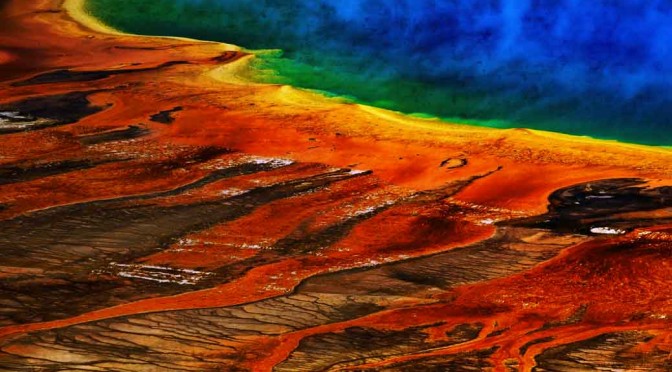Of all the “cool” places we have here on earth, lakes and other water bodies fascinate me the most. This is probably the reason I keep stumbling upon some of the most amazing lakes over and over. In the past I’ve written about the Taal lake and the bleeding lake of Antarctica. I have several others in mind, but this is the one I’ve picked for today, and it isn’t “cool” – The rainbow coloured lake.
Lying amidst the colourful geysers and hot springs of Yellowstone National park, located in the state of Wyoming, is a lake where you’ll see colours ranging from brilliant yellow, orange, red, green and of course blue. Here is what it looks like…
The lake is called the grand prismatic spring and it is the largest hot spring in the US. The water there is hot enough to burn you. And yet…
The hot spring, is home to different kinds of tiny living creatures. Organisms called thermophiles have learnt to thrive in the abnormally hot place. In fact, these creatures depend so much on the heat that they can’t live away from the hot water.
What makes it coloured?
The lake is coloured, yes. But what causes these bright vivid colours? Is it because there is something in the air around it, or is it due to a industrial chemicals leaking into the lake, or is it due to these organisms? Whatever causes the lake to appear coloured, that too colours appearing in the same order like they would be seen on a rainbow, I wanted to know.
Turns out, it isn’t just the lake that is coloured. The steam that arises from the hot water comes in different colours too!
The orange and other non-green/blue colours which appear there the most after blue are due to a multi-layered sheet of microorganisms that thrive in the lake. These are pigmented. The main pigment is chlorophyll (the same thing which helps the plants make food). But chlorophyll is green. So there are some other yellow, red and orange coloured pigments called Carotenoids, that protect the chlorophyll when the sunlight is bright enough to damage it.
The colour of the part of lake is a function of, amount of Carotenoids present with chlorophyll. More the Carotenoid, more colours you’ll see. A greater ratio of cartenoids to protect the chlorophyll during summers is the reason why the lake appears not-so-coloured during winters and vividly coloured during the summers. So, it isn’t the variety of microorganisms or chemicals or atmospheric conditions that colour the lake, the colour is due to the different mix of chlorophyll and carotenoids at different patches of the lake at different times of the year.
The best time to visit this place would thus be the summer season!
Did you like this article?
Every day I send out a newsletter with an un-cut new article and exclusive content for readers. It’s basically my way of keeping in touch with you and letting you know what’s going on. Your information is protected and I never spam.
Subscribe from the sidebar to stay connected. Feel free to reply to these newsletters too…
